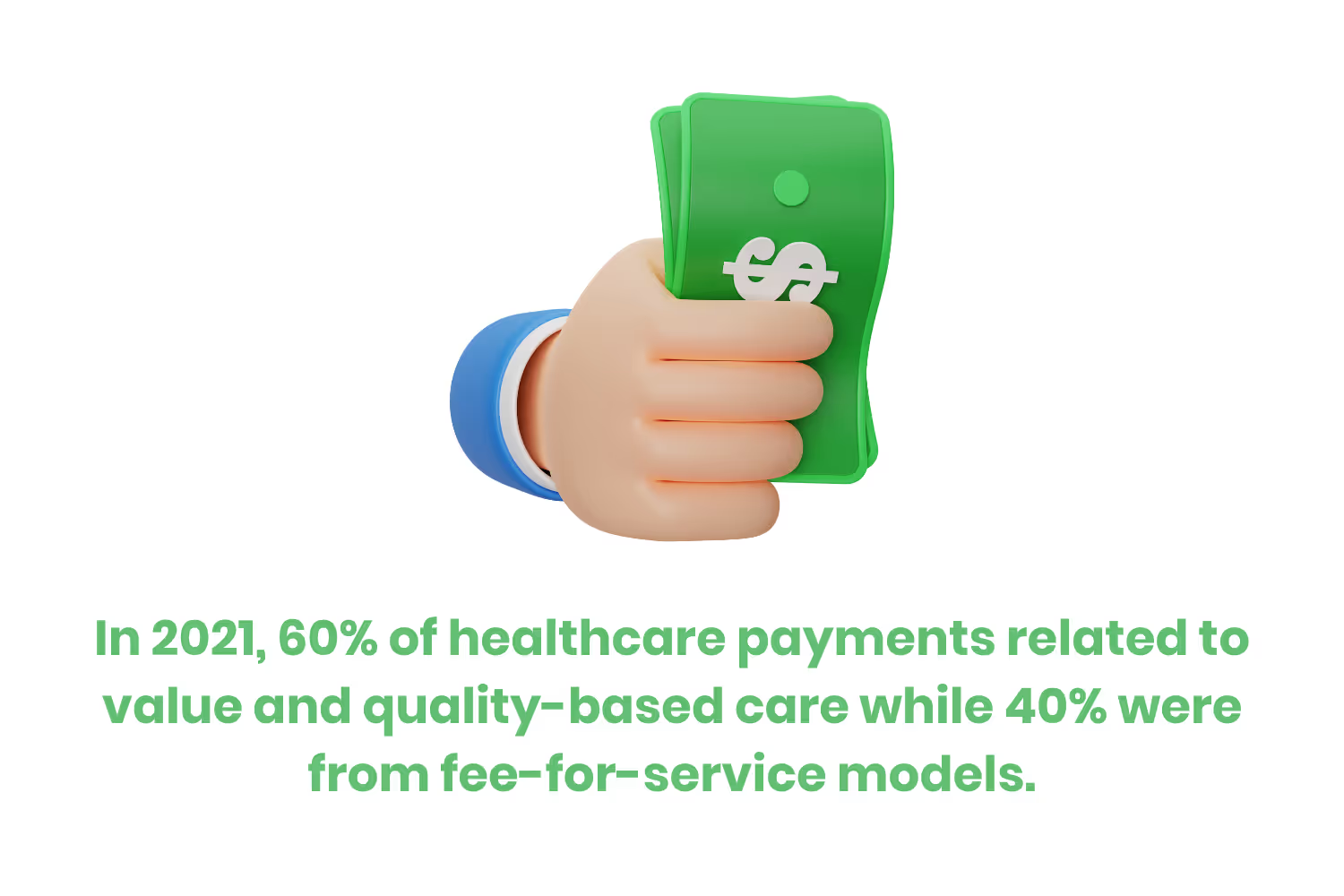Fee for Service Vs. Value Based Care: Key Differences
Let’s take a look at what fee-for-service and value-based care models, the history behind how they came to be, and how they’re different.

Fee-for-service and value-based care exist as polar opposite systems in healthcare. And different goals or motives drive the uses behind both.
In 2021, 60% of healthcare payments related to value and quality-based care while 40% were from fee-for-service models. While we’re seeing an increase in usage in the value-based care system, fee-for-service still follows not too far behind.

Essentially these systems lay out the framework for how healthcare practices carry out business. This includes service and treatment as well as pricing determinations.
Both are widely used and utilized for different purposes depending on the circumstances. Ultimately it all comes down to what works best for operating your practice. So let’s take a look at what they are, the history behind how they came to be, and how they’re different.
What is Fee-for-Service?
Regarding a fee-for-service practice, think of quantity over quality.
A practice that uses a fee-for-service model charges clients separately for each service they receive. This means that the doctor or healthcare provider receives payment for each service they perform. This includes office visits and any kind of testing.
An incentive for practices that use this method is to provide more services to receive more revenue. This is where that quantity over quality analogy comes into play. Some patients may view this as more treatment options while others may see this as not medically necessary.
Let’s go back to an example I used in a previous blog post to put things into perspective. You are a dental practice that offers a variety of services such as teeth cleaning, teeth whitening, x-rays, and so on. All of the services would bill separately or get viewed individually on the patient’s bill that receives these things. Those services can rack up.
So why choose it? Some benefits include higher revenue, more management behind pricing, and strong relationships with clientele.

Practices that use the fee-for-service model as we have learned generate more revenue. They control the services offered to patients as well as the pricing of them. More reimbursement, in fact nearly 100%, goes back into the healthcare practice.
As a fee-for-service practice, that means you are an out-of-network practice. Essentially, it’s exactly what it sounds like. Parenting alongside insurance providers is not one of the main priorities or functionalities of your practice. Since you determine your offerings as well as prices, there is less cooperation between the practitioners and providers.
It can be a bit more tricky to work alongside insurance providers as an out-of-network practice. You might end up spending more time allocating costs.
Since your practice might not be relationally driven with insurance providers, the focus becomes more on your clientele.
It is common to see practices that use this model to have a smaller client base but have stronger retention amongst those clients.
When unnecessary services exist and the quality of them isn’t sufficient, less business may be the result.
History: Fee-for-Services & Value-Based Care
The United States has some of the most high-tech and advanced care in the world; however, an issue that we are seeing across the healthcare industry in the U.S. is its inability to control costs, which are rising faster than any industrialized nation.
Fee-for-service has been around for quite some time, originating from payment rates for physician visits traced to the origins of Blue Cross Blue Shield insurance in the 1930s.
In fact, you can trace its origins all the way back to the passing of the Health Insurance Act of 1926.
FFS payment rates were set at an amount that generously paid physicians for hospitalizations and larger procedures such as surgery.
This is where we begin to see the struggle in the United States regarding medical billing. As we have all heard the term, money doesn’t grow on trees. People were not able to afford these set fees with the fee-for-service model.

There had to be a change in the system. This led to the introduction of multiple different methods in the name of combatting the FFS billing practices.
Not much later down the line, value-based care threw itself into the mix. Implemented in the late 1960s, value-based care was a solution to the rising healthcare costs and reduced quality of care.
People were not able to afford healthcare costs. Multiple acts such as Title XVIII and Title XIX of the Social Security Act came to fruition in 1965 to aid retirees, certain low-income individuals, and the medically underserved.
In contrast to fee-for-service, where billing relies on the amount of services and not so much on necessity, value-based care reimbursement depends on the quality of care.
We can view the fee-for-service as the groundwork for how paying physicians began. Newer models such as value-based care experience a lot of changes in the name of helping the patients in paying for healthcare costs.
What is Value-Based Care
Let’s move on to the value-based care system.
There’s a focus on the patient experience. Patients exist at the center here so their outcomes determine monetary results for doctors or the practice.
This is because there’s more accountability placed on healthcare providers for patient outcomes. For value-based care think the opposite of fee-for-service: quality over quantity.
Value-based care is quality over quantity. Rather than separating services…they’re bundled together.
Quality of care as well as provider performance are significant factors taken into consideration with determining success in value-based care. The amount of money that providers receive depends on those factors.
Since 2021, this is a model we’ve seen more and more practices begin to follow for multiple reasons such as a steady increase in healthcare costs and limited access to necessary supplies and tools.
The goal is to achieve better care for individuals, better health for populations and all at a lower cost.
All of this sounds great and the shift that healthcare needs to see in billing. But, to achieve a value-based care system a few things need to take place.

A lot of analysis and understanding comes with putting this model into application. You have to understand your client’s needs to be able to treat them better or make things more convenient.
A simple example of this would be if a patient has to get bloodwork done, scheduling their testing on the same day so it only takes one trip.
Data managing skills are very important when it comes to value-based care. A strong IT infrastructure is a must to identify those areas where you are lacking, figure out how you are going to improve, and then measure improvements. Evaluation is essential. You can’t just hit the ground running. You need information to start somewhere.
You also need to have access to patient history and information to promote better care coordination or reduce medical errors. It takes a team effort to make the benefits of value-based care come to fruition…but as they do, the payoff is huge.
According to Humana, over the past decade, patients receiving health care under value-based care arrangements have grown by 2.3 million.
2022 showed a record 70% of Individual Medicare Advantage patients aligned with value-based care providers.
There is more cooperation seen between healthcare providers, patients and insurance providers in this model.
Due to the higher levels of patient satisfaction and better care efficiencies, there is a benefit to the insurance providers that you are partnering alongside. Extending partnerships is a crucial part of the value-based care method.
To increase convenience for your clients, working with a multitude of insurance providers reduces the risk of no coverage. This also provides you with stronger cost controls.
Conclusion
We are seeing a shift in the healthcare system in many ways. One of those changes is in billing systems and or models.
fee-for-service and value-based care are two widely known systems. fee-for-service has been around for quite some time. As time goes on and we see the constant increase in healthcare costs, value-based care is stepping up into the preferred way to go about paying for medical bills.
If you take one thing away from this blog let it be this: when thinking of fee-for-service remember quantity over quality. An easy way to understand what “value-based care” means is to view it as, “quality over quantity”.
Both models have their perks while also having their weak points.
If you’re a practice that offers a variety of services to retentive clientele, the fee-for-service model might be for you. If you also like holding the reins when it comes to costing it might be the way to go. There’s less cooperation between you and insurance providers but more interaction among patients.
Value-based care is very popular in this day and age. Patients exist at the center and reimbursement depends on their outcomes. value-based care takes a lot of analysis and evaluation to make sure what you are doing is actually effective. When done correctly the patient payout is well worth it.
Not only does this make things more convenient for patients, but helps you in the long run as well. Decreasing errors and increasing the overall well-being of patients proves great results.
Emphasize your product's unique features or benefits to differentiate it from competitors
In nec dictum adipiscing pharetra enim etiam scelerisque dolor purus ipsum egestas cursus vulputate arcu egestas ut eu sed mollis consectetur mattis pharetra curabitur et maecenas in mattis fames consectetur ipsum quis risus mauris aliquam ornare nisl purus at ipsum nulla accumsan consectetur vestibulum suspendisse aliquam condimentum scelerisque lacinia pellentesque vestibulum condimentum turpis ligula pharetra dictum sapien facilisis sapien at sagittis et cursus congue.
- Pharetra curabitur et maecenas in mattis fames consectetur ipsum quis risus.
- Justo urna nisi auctor consequat consectetur dolor lectus blandit.
- Eget egestas volutpat lacinia vestibulum vitae mattis hendrerit.
- Ornare elit odio tellus orci bibendum dictum id sem congue enim amet diam.
Incorporate statistics or specific numbers to highlight the effectiveness or popularity of your offering
Convallis pellentesque ullamcorper sapien sed tristique fermentum proin amet quam tincidunt feugiat vitae neque quisque odio ut pellentesque ac mauris eget lectus. Pretium arcu turpis lacus sapien sit at eu sapien duis magna nunc nibh nam non ut nibh ultrices ultrices elementum egestas enim nisl sed cursus pellentesque sit dignissim enim euismod sit et convallis sed pelis viverra quam at nisl sit pharetra enim nisl nec vestibulum posuere in volutpat sed blandit neque risus.

Use time-sensitive language to encourage immediate action, such as "Limited Time Offer
Feugiat vitae neque quisque odio ut pellentesque ac mauris eget lectus. Pretium arcu turpis lacus sapien sit at eu sapien duis magna nunc nibh nam non ut nibh ultrices ultrices elementum egestas enim nisl sed cursus pellentesque sit dignissim enim euismod sit et convallis sed pelis viverra quam at nisl sit pharetra enim nisl nec vestibulum posuere in volutpat sed blandit neque risus.
- Pharetra curabitur et maecenas in mattis fames consectetur ipsum quis risus.
- Justo urna nisi auctor consequat consectetur dolor lectus blandit.
- Eget egestas volutpat lacinia vestibulum vitae mattis hendrerit.
- Ornare elit odio tellus orci bibendum dictum id sem congue enim amet diam.
Address customer pain points directly by showing how your product solves their problems
Feugiat vitae neque quisque odio ut pellentesque ac mauris eget lectus. Pretium arcu turpis lacus sapien sit at eu sapien duis magna nunc nibh nam non ut nibh ultrices ultrices elementum egestas enim nisl sed cursus pellentesque sit dignissim enim euismod sit et convallis sed pelis viverra quam at nisl sit pharetra enim nisl nec vestibulum posuere in volutpat sed blandit neque risus.
Vel etiam vel amet aenean eget in habitasse nunc duis tellus sem turpis risus aliquam ac volutpat tellus eu faucibus ullamcorper.
Tailor titles to your ideal customer segment using phrases like "Designed for Busy Professionals
Sed pretium id nibh id sit felis vitae volutpat volutpat adipiscing at sodales neque lectus mi phasellus commodo at elit suspendisse ornare faucibus lectus purus viverra in nec aliquet commodo et sed sed nisi tempor mi pellentesque arcu viverra pretium duis enim vulputate dignissim etiam ultrices vitae neque urna proin nibh diam turpis augue lacus.



![[ANSWERED] What is a Long-Term Care (LTC) Pharmacy](https://cdn.prod.website-files.com/67e2b8210878abcba6f91ae6/68d687806a075a1cf64659b0_WhatisLongTermCarePharmacy_925.avif)
